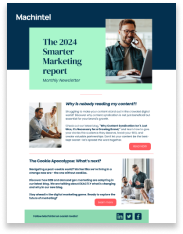Mastering Lead Generation: Modern Marketing Strategies Insights from Setareh Motamedi, the VP of Growth Marketing at 1Password
Choosing the ideal marketing channels frequently baffles marketers. Should we diversify across many channels or hone in on just a few? More importantly, how do we ensure our message hits home?
I had the privilege of delving into these queries with Setareh Motamedi, VP of Growth Marketing at 1Password. Our discussion illuminated the prevalent hurdles in lead generation and proposed tangible solutions.
“We aim to captivate customers much earlier in the buying journey. The true metric of success lies in mastering demand creation. While a broad target market provides diverse entry points and visibility opportunities, ultimately, our strategy pivots around our business model and objectives.”
So, which marketing channels resonate most with potential customers? SEO tops the list, and here's why:
- It's enduring and boasts infinite growth potential. Rankings can be continually enhanced and content optimized.
- It’s cost-effective, with the primary investment in SEO tools. In contrast, the visibility of Google Ads and similar paid sources hinges on your budget.
- As Hubspot's SOMR suggests, consumers lend more credibility to organic search results over paid or sponsored ads.
- It allows for specificity. Regardless of industry or persona, crafting content with the right tone, language, and keywords is essential. Succeeding in organic and technical SEO can yield substantial dividends.
Should companies laser-focus on specific channels or cast a wider net?
The distinction between capturing and creating demand is pivotal. A mere 1-3% of the market is actively purchasing at any given time.
Exclusively targeting this demographic can lead to underwhelming revenue and deal closures. Catering to this active segment is about capturing existing demand.
However, the remaining 97-99% represents untapped potential. This dormant segment might not be purchasing now, but with the right approach to demand creation, they'll recall your brand when they do.
Bain & Co.'s research underscores that by the time consumers approach you, they've solidified 80% of their buying decisions, typically between just two brands.
Many firms get bogged down in battling for the attention of the actively purchasing minority. While this has its merits, the real goldmine lies in engaging the 99% who aren't currently in the market. If you only make your move when they're ready to buy, you're already behind.
How can businesses align with their target market's preferences?
The answer lies in two words: qualitative research. Regularly interacting with your customers is invaluable. Relying solely on quantitative data leaves gaps; both forms of research should coexist within a marketing strategy. To truly understand your audience, solicit direct feedback, establish a customer advisory board, and harness the power of focus groups.
Defining "quality leads" is subjective. However, I advocate a modern approach, especially for mid-market and enterprise businesses. Traditional metrics like MQLs and SQLs are becoming obsolete. Instead, the real measure of a quality lead should be the rate of sales progression and the revenue booked through marketing initiatives.
To grasp this, consider:
- Opportunity Source: How did the lead enter your pipeline? This can give insights into their buying intent.
- Pipeline Value (PV): Use metrics to gauge your demand capture effectiveness.
Some conventional marketing techniques may seem outdated, but with a twist, they can be revitalized:
- LinkedIn: Forego generic pitches. Instead, adopt an authentic approach, offer value, and draw parallels with competitors to highlight your edge.
- Cold Emails: Ditch boilerplate content. Instead, curate a brief personalized video pinpointing their business challenges and how you can mitigate them.
Content marketing isn't just about writing; it's your brand's voice and value proposition. According to Hubspot's report, blogs, social media, and influencer marketing yield the highest ROI. With waning trust in paid ads, the spotlight is now on genuine, value-driven content.
Call-to-actions (CTAs) play a crucial role in conversion rates. The pitfall many companies fall into is placing CTAs too prematurely. It's essential to synchronize CTAs with the customer journey, and impeccable user experience is the key.
When deploying a multi-channel marketing approach, consistency is paramount. However, differentiation is equally vital:
- Tailored Taglines: Adapt your messaging for each platform without diluting its essence.
- Emotional Consistency: Your brand's core values should resonate across all channels.
- Cross-Channel Collaboration: Encourage synergy between teams managing different channels to ensure uniformity in messaging.
Responding to industry shifts without jeopardizing brand values can be tricky:
- Stay True to Your Values: Any adaptation should be in sync with your brand's core ethos.
- Avoid Inauthenticity: Jumping on trends for the sake of it can backfire.
- Unique Perspective: Your brand's take on a trend should be genuine and aligned with its identity.
To enhance post-interaction engagements:
- Personalized Content: Address specific challenges raised by leads.
- Educational Resources: Equip them with insights pertinent to their concerns.
- Social Proof: Build trust through testimonials and references.
Lead generation remains a tough nut to crack, with a whopping 68% of businesses admitting challenges, per an APSIS study. However, with SEO as a formidable weapon and a balanced approach to demand capture and creation, success is attainable.
Ready to elevate your lead generation game?
Contact us for a conversation or watch the full Q&A with Setareh.
Recent Posts




By submitting this form I have read and acknowledged the Terms of Use and the Privacy policy
